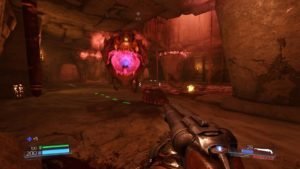Doom starts off with Doomguy bashing a skull onto the table you’re lying on while breaking the chains holding him to said table. Well, no. It starts you off by accepting a bunch of terms of agreement, but once you’ve gone through that fuss, Doomguy bashs that skull in harder than Edward Norton. From there, you’ll shotgun, explode, eviscerate, and shoot anything and everything that moves. There’s gore in excess. A desolate landscape ravaged by violence, bloodshed, and horror. Somewhat reminiscent of the Vietnam War, but with less fire and moral ambiguity.
Doom sticks to the 90’s FPS mantra of fast-paced action, huge explosions, and visceral fun for the hell of it. It was interesting playing Doom through the lens of Wolfenstein: The New Order, a game that abandoned some of that heart-racing action and substituted it for an intricate story, laced with questions of choice and inevitability in ways that few games have managed. The New Order took a hard turn right when asked how familiar it would be to its predecessors, taking the more complex and artistic detour. Doom meet the same intersection, changes gears, and speeds down the highway while flipping off the cops waiting at a red light.
The name of the game is demon killing. Rush Doomguy through a level at a record land speed, kill a horde of enemies Quentin Tarantino style, find some secrets, move on to the next level. Repeat until the game tells you there’s nothing left to kill. Doom attempts to set up some assemblance of a plot, but it’s drowned, both literally and figuratively, in blood, action, and gibs. It discusses something about using a resource in Hell to harvest some energy source that powers all of Earth, and some scientist cult woman deciding she’d rather unleash Hell on Mars.
 The plot feels somewhat reminiscent of Dead Space, with some random cult off in a sci-fi setting attempting to bring in this otherworldy force. They, of course, have no idea how to manipulate, control, or even interact with the demons on a basic level other than self preservation and dying, but that doesn’t stop the cult from trying. The portal opening works, and surprise, everyone is either turned into Mars mulch or some sort of possessed demon. It’s now up to Doomguy to kill, amputate, and gut punch everything he sees until it goes back to Hell.
The plot feels somewhat reminiscent of Dead Space, with some random cult off in a sci-fi setting attempting to bring in this otherworldy force. They, of course, have no idea how to manipulate, control, or even interact with the demons on a basic level other than self preservation and dying, but that doesn’t stop the cult from trying. The portal opening works, and surprise, everyone is either turned into Mars mulch or some sort of possessed demon. It’s now up to Doomguy to kill, amputate, and gut punch everything he sees until it goes back to Hell.
That’s not important, though, to playing Doom. The plot merely exists as a reason to murder demons in ways that would make mother cringe at the first sight. And while there are some additions to the gameplay and shinier graphics, most of the run-and-gun fun from the 90’s has been practically copy/pasted from the originals. It was almost nice not needing some contrived reason for killing the enemies: they’re demons, and you’re something demons kill. It would be in your best interest, therefore, to just kill them yourself and save them the trouble.
All of the classic weapons from the original two games reappear with some interesting additions: a heavy assault rifle, gausse cannon, and equipment like grenades and holograms. The weapons all feel and shoot well, with rocket shots always a great source of gibs production. The chainsaw’s use has changed, though. When an enemy is killed with the chainsaw, they break open like a piñata filled with ammo, leaving the chainsaw as a handy backup when ammo is low. However, the chainsaw requires gas to use, meaning that it’s a good last-resort option to tap into when ammo is low and demons are tall.

Health and armor still function in the same capacity. No regenerating health behind cover, you have to earn your health fair and square by picking it up off the ground or by taking it out of health dispenser labeled as “enemies” through glory kills. This is when an enemy staggers after taking a fair chunk of damage, where Doomguy re-purposes an arm as a club or help an Imp attain its goal of having the ability to open its jaw like a snake. Doomguy also still runs faster than any living creature on Earth, although his speed does feel as though its been reduced. As a replacement, Id Software threw in Rocket Boots, allowing for double jumps and better maneuvering around the environment.
Most weapons come with two different upgrades, usually with one useful one and one worthless one. The assault rifle, for example, can be upgraded with either a scope to see enemies better or mini rockets that can shoot six at a time. The combat shotgun comes with a charged triple shot or an explosive slug. The upgrades can only be found by looking for these floating robots that distribute them. Although even after grabbing an upgrade from them, Doomguy proceeds to punch the little guy in the eyepiece with the same sort of blasé most would have when shaking someone’s hand. The upgrades helped keep the weapons from feeling stale, constantly providing something new to work for, like reducing the load time for rockets or additional effects when directly hitting enemies.
The levels are fairly well-designed, although there is an awkward difference between the levels on Mars and those in Hell. Those on Mars are more open and feel almost like Bloodborne or a Dark Souls title, with pathways twisting and turning around each other. It is also where the game would begin to stutter. Every now and then, the game would take a second to breathe and figure out what it was doing next, which is quite annoying when I’m mid-shotgun blast into a Possessed’s chest or replacing the eye of a Baron of Hell with one of his horns. These stutters create gaps in the flow of combat, disrupting how the battle would feel. There are some graphic changes players can tinker with to help this, but even after lowering everything and turning off motion blur, Doom would still stutter every now and then.

Levels in Hell feel much more like classic Doom. Narrow corridors, tight spaces, rooms filled with enemies to butcher, hidden doors opening up as the game progresses, floating platforms, all gave off a feel more akin to classic Doom. There was also not one stutter during the Hell levels, allowing for combat to keep its pace as it should.
The separation between Mars and Hell is an apt comparison to how the game feels in total. When on Mars, Doom feels like it was forcing more than it could handle, both from the hardware given and the type of the game it is looking to be. The plot feels half-hearted next to the mindless killing Doom keeps asking the player to accomplish. Hell, though, is much more to form. The levels are concise and focused, and the game feels like it has more energy. No plot or circumstance to bog the player down. Just keep moving forward and turning everything organic into a fine paste.
The fast-paced action and use of excess, both in its visual theme and mechanics, would probably look somewhat average twenty years ago. But in a world where most shooters are becoming more reserved than a British Parliament member, the excess and over-the-top action is an exciting change of pace. Doom isn’t ashamed of its gore, killing, or reveling in excess; it boldly embraces it, and in bringing something from the days of old, where you’d plug in controllers into the printer port and swap floppy discs in and out when loading new levels, it brings something new to this generation of gaming: pure, unadultrated fun.

